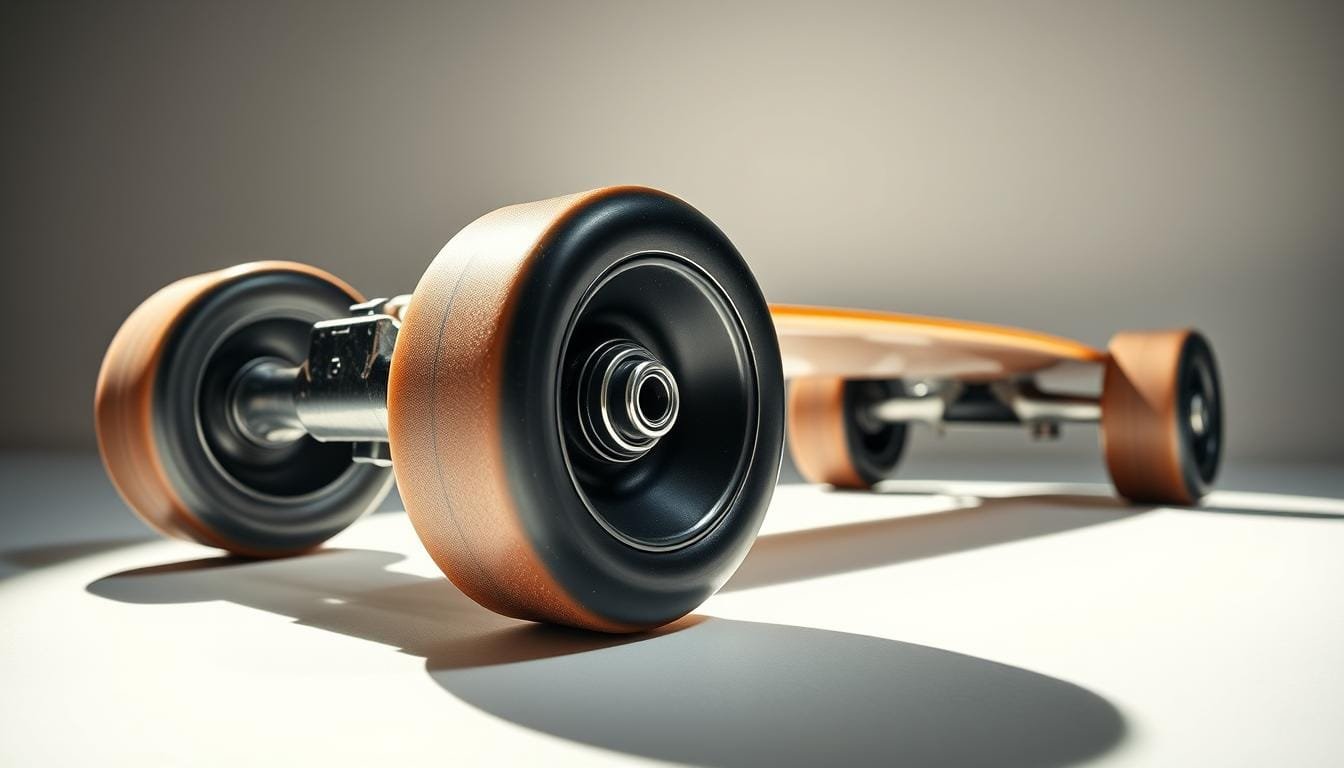Choosing the right cruising skateboard involves many factors, skateboard wheel size being crucial. The debate on bigger wheels’ pros and cons is intense. Do they offer more benefits or problems? We’ll look into how bigger wheels affect cruising skateboards’ speed, stability, and performance on various surfaces.
Key Takeaways
- The first urethane skateboard wheel was introduced in the 1970s, revolutionizing skating technology.
- Skateboard wheel sizes typically range from 50mm to 75mm in diameter.
- Soft wheels (78A-87A) are ideal for cruising because they grip well and are comfy on uneven surfaces.
- Larger wheels (60mm and above) are better for bumpy ground, making the ride smoother.
- The durometer rating tells us how hard the wheels are, affecting their speed and grip.
- For beginners and those riding on bumpy terrains, wheels between 54-59mm are suggested.
- Finding the right balance between wheel size and durometer enhances the cruising experience.
Understanding the Importance of Wheel Size for Cruising
Skateboard wheels are key for a great ride. The effect of wheel size on skateboarding influences speed and control. For cruising, big wheels are usually better. But why?
Wheels vary from 50 mm to 75 mm. Small wheels (50-53 mm) are fast to start but not good for rough surfaces. Larger wheels (60 mm and up) keep speed better and ride smoothly, which is great for cruising.
Wheel hardness matters too for cruising. Durometer A Scale shows wheel hardness from soft (78A) to very hard (101A+). Soft wheels (78A-87A) are good on uneven surfaces, making rides comfortable. Hard wheels (96A-101A+) are better for tricks and fast skating.
Wheel shape also impacts your ride. Rounded wheels are for street skating, and square wheels provide stability for cruising. The contact patch affects rolling resistance, with larger patches offering more stability but possibly reducing speed a bit.
For cruising, you need balanced wheels. Medium-sized wheels (54-59 mm) can be great for different skating styles. Brands like Sector 9 and Arbor have great cruising wheels with technology for better speed and durability.
To learn more about skateboard wheel dynamics and finding the right cruising wheels, visit this comprehensive guide.
Benefits of Bigger Wheels for Cruising
Large skateboard wheels offer many perks for cruising. They give a smoother ride over cracks and debris. Thanks to their size, they can absorb shocks and lower vibrations better than smaller wheels.
Bigger wheels also improve enhanced stability, crucial for a secure ride. Their broad surface and large contact patch provide more grip. This is great for balance and confidence over long distances.
They also keep speed better, reaching higher top speeds. This means a smoother ride over different surfaces. This can be really helpful for those who commute on skateboards. For cruising, wheels between 56mm and 60mm, with a hardness of 78a to 87a, are ideal.
These wheels also mean less pushing, which eases physical effort. Riders can enjoy longer, more relaxed rides. For the best skateboarding experience, the benefits of large wheels are clear. The right wheels can greatly improve your ride.
Potential Drawbacks of Larger Wheels
Choosing larger wheels for your skateboard can make cruising better. However, you need to think about several downsides. A major problem is wheel bite. This happens when your wheels hit the deck during fast turns or tricks. It can cause sudden stops and falls.
Also, increased board height from bigger wheels might make your skateboard harder to control. It can make doing technical tricks more difficult. Smaller wheels, used by street skaters, offer better control for tricks. Those skaters usually pick wheels between 50mm and 56mm. Meanwhile, transition skaters, who want smooth speeds, choose wheels a bit over 55mm.
Bigger wheels mean you might need riser pads to avoid wheel bite. For wheels above 60mm, installing about 1/2″ riser pads is crucial. This makes the board higher and can feel less steady, especially for beginners. An article on Doctor Skate suggests riser pads reduce wheel bite but affect your balance.
Understanding the cons of large wheels can prepare you to deal with them. You might choose softer wheels for better grip or tweak how you skate. Your choice should match your skating style and what you enjoy about cruising.
Choosing the Right Wheel Size for Your Needs
Choosing the right skateboard wheels for your cruiser is key. It all depends on how you skate, where you skate, and what you like. Each wheel size offers something different.
The diameter of wheels usually ranges from 50 mm to 75 mm. Smaller wheels (50-53 mm) are best for tricks and lightweight skaters. Average-sized wheels (54-59 mm) are great for beginners and heavier riders, making skateboarding customized for everyone.
Wheel hardness, or durometer, matters too. Most skateboard wheels have a durometer of 99a. Soft wheels (78a-87a) are perfect for uneven surfaces and grip well. Wheels between 88a-95a are a bit harder but still offer good grip. If you like smooth surfaces, choose wheels with a 96a-99a rating for speed and grip.
| Skateboard Type | Diameter (mm) | Durometer (A Scale) |
|---|---|---|
| Park/Street Wheels | 50-54 mm | 95-101A |
| Cruiser/Soft Wheels | 54-60 mm | 78-90A |
| Longboard Wheels | 60-75 mm | 75-85A |
If you’re setting up a cruiser, wheels with a 90A to 98A durometer are comfy on rough surfaces. For bigger wheels (over 56 mm), you might need riser pads. They stop wheel bite and add clearance.
In the end, your skateboarding experience depends on wheel size, diameter, and durometer. By selecting skateboard wheels that fit your needs, you’re set for a smooth and fun ride. This applies to both beginners and seasoned skaters.
Popular Brands Offering Bigger Wheels
Many top skateboard brands provide high-quality cruiser wheels. Names like Bones Wheels, Autonomy Skateboarding, and others are well-known. They produce wheels that make cruising smooth and enjoyable.
Bones Wheels uses the Shore B scale for wheel hardness. This assures top-notch precision and quality. Their wheels are durable and come in sizes from 54 mm to more than 60 mm. This is great for cruising.
Spitfire Wheels is another famous brand. They make Formula Four Radial wheels, available in sizes such as 58 mm. With a durometer of 93a, these wheels offer a great mix of speed and grip. They’re perfect for smooth rides on different surfaces.
Let’s take a closer look at the options from various brands:
| Brand | Wheel Size Range | Durometer Range | Special Features |
|---|---|---|---|
| Bones Wheels | 54-60 mm | 78A-85A | Shore B scale |
| Spitfire Wheels | 58 mm | 93A | Formula Four |
| EZ Hawgs | 60 mm | 78A-85A | High durability |
| Fatty Hawgs | 63 mm | 77A-85A | Fatty profile |
EZ Hawgs and Fatty Hawgs stand out for their cruiser wheels. EZ Hawgs offer wheels in 60 mm size and Fatty Hawgs in 63 mm size. They’re great for those wanting wheels between 55 mm to 65 mm. Their wheels are soft, between 77a and 85a. This makes them perfect for smooth rides on many types of ground.
When picking wheels, think about what you need for cruising. Choosing larger wheels from these reliable brands can make cruising better. And you’re sure to get wheels that last long and fit your cruising style.
Conclusion: Making the Best Choice for Your Cruising Experience
Choosing the right wheels for your cruising skateboard is key. Wheel size, durometer rating, and shape all matter. They affect how stable, grippy, and well-performing your skateboard is on different surfaces.
Skateboard wheels range from 50mm to 75mm. For cruising, bigger wheels (60mm and up) are better. They roll faster and smoother over rough spots. The ideal hardness is between 78A and 87A. This gives great grip and softens bumps.
Selecting the best skateboard wheels means thinking about how and where you ride. No matter your skill level, the right wheels make your ride more fun and easy. Choosing well is crucial for a smoother, more controlled skateboard journey.

I’m John Peterson, a passionate skater, blogger, and lifelong enthusiast. I’ve been skating for over 9 years and have gone on to write a blog dedicated to the sport of skating and its culture. Through my blog, I strive to share my knowledge and experience of the sport with all who are interested. From beginner tips, tricks, and equipment reviews to interviews and event coverage, I cover it all. So read my blog as I explore the wonderful world of skating!

